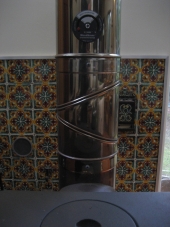posted 2 years ago
I have a wood-burning cooking stove installed to a existing chimney in my house now. It´s an old unit and it doesn´t burn particularly well. It always smokes kind of partly black despite going full blast and it smells outside. It also produces quite a lot of creosote in the chimney pipe and even some almost grass/algea-looking ash fibers inside the unit itself. Still, it is very usable and cooks and heats well, but I have to do something about the dirty burn to partly not needing to clean the chimney every 3 months and partly to not make the neighbours cough.
This have lead to the plan to replace the cooking unit with a small batch box rocket mass heater with a directly feeded brick bell. The problem I have is to decide the dimensions, and I am not totally sure that the current chimney solution will work. I think part of the current dirty burn problem is caused by the chimney. It is a strange solution (not made by me, but from the previous owner of the house. Going from the stove and up, I have 120mm (4.7 inches) pipe from the stove. Then it goes straight up to a 90 degree turn, then left horizontally 20 inches, then turns 90 degrees again and goes horizontally straight forward into a brick chimney, then turns ANOTHER 90 degree turn upwards into a small about 6 times 6 inches rectangular chamber (seen by an inspection camera) and then exits up to a straight 3m 100mm steel pipe (3,9 inches) that is inside the old chimney. So it is basically straight up, then turn-turn-turn-chamber-pipe reduction-straight up through the roof. My guess is that the turns and the volume reduction of the chimney along the way destroys the draft possibilities and creates a tough task for the stove.
The pipe inside the chimney is not easily replaced and my guess is that they had problems fitting a 120mm pipe and then went for a slightly smaller option just to get it down.
Anyway, what would you say would be the best dimensions for the core design for the RMH? And how to do with the chimney to try to get as good draft as possible? Is it better to go 100mm to be sure that I don´t over-feed the upper 100mm pipe? And then replace all external pipes outside of the chimney to 100mm. Or do you think that a 120mm core can work with a 100mm chimney pipe? I for sure don´t want to risk back-smoking or lack of draft again, since I have that problem today already and that is what I am trying to solve in the first place.
The bell size is no problem. I can do whatever fits, basically. I have plenty of room. So it is only the burn quality and safety that matters, really.









